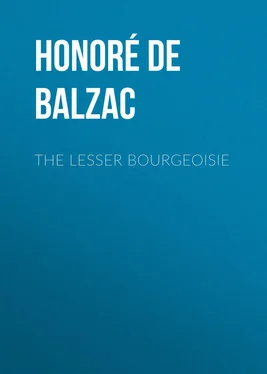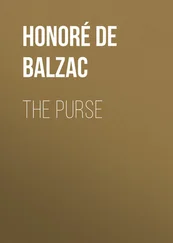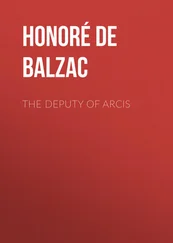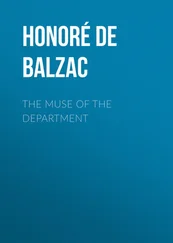Honoré Balzac - The Lesser Bourgeoisie
Здесь есть возможность читать онлайн «Honoré Balzac - The Lesser Bourgeoisie» — ознакомительный отрывок электронной книги совершенно бесплатно, а после прочтения отрывка купить полную версию. В некоторых случаях можно слушать аудио, скачать через торрент в формате fb2 и присутствует краткое содержание. Жанр: literature_19, foreign_antique, foreign_prose, на английском языке. Описание произведения, (предисловие) а так же отзывы посетителей доступны на портале библиотеки ЛибКат.
- Название:The Lesser Bourgeoisie
- Автор:
- Жанр:
- Год:неизвестен
- ISBN:нет данных
- Рейтинг книги:3 / 5. Голосов: 1
-
Избранное:Добавить в избранное
- Отзывы:
-
Ваша оценка:
- 60
- 1
- 2
- 3
- 4
- 5
The Lesser Bourgeoisie: краткое содержание, описание и аннотация
Предлагаем к чтению аннотацию, описание, краткое содержание или предисловие (зависит от того, что написал сам автор книги «The Lesser Bourgeoisie»). Если вы не нашли необходимую информацию о книге — напишите в комментариях, мы постараемся отыскать её.
The Lesser Bourgeoisie — читать онлайн ознакомительный отрывок
Ниже представлен текст книги, разбитый по страницам. Система сохранения места последней прочитанной страницы, позволяет с удобством читать онлайн бесплатно книгу «The Lesser Bourgeoisie», без необходимости каждый раз заново искать на чём Вы остановились. Поставьте закладку, и сможете в любой момент перейти на страницу, на которой закончили чтение.
Интервал:
Закладка:
Honoré de Balzac
The Lesser Bourgeoisie
Here, madame, is one of those books which come into the mind, whence no one knows, giving pleasure to the author before he can foresee what reception the public, our great present judge, will accord to it. Feeling almost certain of your sympathy in my pleasure, I dedicate the book to you. Ought it not to belong to you as the tithe formerly belonged to the Church in memory of God, who makes all things bud and fruit in the fields and in the intellect?
A few lumps of clay, left by Moliere at the feet of his colossal statue of Tartuffe, have here been kneaded by a hand more daring than able; but, at whatever distance I may be from the greatest of comic writers, I shall still be glad to have used these crumbs in showing the modern Hypocrite in action. The chief encouragement that I have had in this difficult undertaking was in finding it apart from all religious questions, – questions which ought to be kept out of it for the sake of one so pious as yourself; and also because of what a great writer has lately called our present “indifference in matters of religion.”
May the double signification of your names be for my book a prophecy! Deign to find here the respectful gratitude of him who ventures to call himself the most devoted of your servants.
De Balzac.PART I. THE LESSER BOURGEOIS OF PARIS
CHAPTER I. DEPARTING PARIS
The tourniquet Saint-Jean, the narrow passage entered through a turnstile, a description of which was said to be so wearisome in the study entitled “A Double Life” (Scenes from Private Life), that naive relic of old Paris, has at the present moment no existence except in our said typography. The building of the Hotel-de-Ville, such as we now see it, swept away a whole section of the city.
In 1830, passers along the street could still see the turnstile painted on the sign of a wine-merchant, but even that house, its last asylum, has been demolished. Alas! old Paris is disappearing with frightful rapidity. Here and there, in the course of this history of Parisian life, will be found preserved, sometimes the type of the dwellings of the middle ages, like that described in “Fame and Sorrow” (Scenes from Private Life), one or two specimens of which exist to the present day; sometimes a house like that of Judge Popinot, rue du Fouarre, a specimen of the former bourgeoisie; here, the remains of Fulbert’s house; there, the old dock of the Seine as it was under Charles IX. Why should not the historian of French society, a new Old Mortality, endeavor to save these curious expressions of the past, as Walter Scott’s old man rubbed up the tombstones? Certainly, for the last ten years the outcries of literature in this direction have not been superfluous; art is beginning to disguise beneath its floriated ornaments those ignoble facades of what are called in Paris “houses of product,” which one of our poets has jocosely compared to chests of drawers.
Let us remark here, that the creation of the municipal commission “del ornamento” which superintends at Milan the architecture of street facades, and to which every house owner is compelled to subject his plan, dates from the seventeenth century. Consequently, we see in that charming capital the effects of this public spirit on the part of nobles and burghers, while we admire their buildings so full of character and originality. Hideous, unrestrained speculation which, year after year, changes the uniform level of storeys, compresses a whole apartment into the space of what used to be a salon, and wages war upon gardens, will infallibly react on Parisian manners and morals. We shall soon be forced to live more without than within. Our sacred private life, the freedom and liberty of home, where will they be? – reserved for those who can muster fifty thousand francs a year! In fact, few millionaires now allow themselves the luxury of a house to themselves, guarded by a courtyard on a street and protected from public curiosity by a shady garden at the back.
By levelling fortunes, that section of the Code which regulates testamentary bequests, has produced these huge stone phalansteries, in which thirty families are often lodged, returning a rental of a hundred thousand francs a year. Fifty years hence we shall be able to count on our fingers the few remaining houses which resemble that occupied, at the moment our narrative begins, by the Thuillier family, – a really curious house which deserves the honor of an exact description, if only to compare the life of the bourgeoisie of former times with that of to-day.
The situation and the aspect of this house, the frame of our present Scene of manners and morals, has, moreover, a flavor, a perfume of the lesser bourgeoisie, which may attract or repel attention according to the taste of each reader.
In the first place, the Thuillier house did not belong to either Monsieur or Madame Thuillier, but to Mademoiselle Thuillier, the sister of Monsieur Thuillier.
This house, bought during the first six months which followed the revolution of July by Mademoiselle Marie-Jeanne-Brigitte Thuillier, a spinster of full age, stands about the middle of the rue Saint-Dominique d’Enfer, to the right as you enter by the rue d’Enfer, so that the main building occupied by Monsieur Thuillier faces south.
The progressive movement which is carrying the Parisian population to the heights along the right bank of the Seine had long injured the sale of property in what is called the “Latin quarter,” when reasons, which will be given when we come to treat of the character and habits of Monsieur Thuillier, determined his sister to the purchase of real estate. She obtained this property for the small sum of forty-six thousand francs; certain extras amounted to six thousand more; in all, the price paid was fifty-two thousand francs. A description of the property given in the style of an advertisement, and the results obtained by Monsieur Thuillier’s exertions, will explain by what means so many fortunes increased enormously after July, 1830, while so many others sank.
Toward the street the house presents a facade of rough stone covered with plaster, cracked by weather and lined by the mason’s instrument into a semblance of blocks of cut stone. This frontage is so common in Paris and so ugly that the city ought to offer premiums to house-owners who would build their facades of cut-stone blocks. Seven windows lighted the gray front of this house which was raised three storeys, ending in a mansard roof covered with slate. The porte-cochere, heavy and solid, showed by its workmanship and style that the front building on the street had been erected in the days of the Empire, to utilize a part of the courtyard of the vast old mansion, built at an epoch when the quarter d’Enfer enjoyed a certain vogue.
On one side was the porter’s lodge; on the other the staircase of the front building. Two wings, built against the adjoining houses, had formerly served as stables, coach-house, kitchen and offices to the rear dwelling; but since 1830, they had been converted into warerooms. The one on the right was let to a certain M. Metivier, jr., wholesale dealer in paper; that on the left to a bookseller named Barbet. The offices of each were above the warerooms; the bookseller occupying the first storey, and the paper-dealer the second storey of the house on the street. Metivier, jr., who was more of a commission merchant in paper than a regular dealer, and Barbet, much more of a money lender and discounter than a bookseller, kept these vast warerooms for the purpose of storing, – one, his stacks of paper, bought of needy manufacturers, the other, editions of books given as security for loans.
Читать дальшеИнтервал:
Закладка:
Похожие книги на «The Lesser Bourgeoisie»
Представляем Вашему вниманию похожие книги на «The Lesser Bourgeoisie» списком для выбора. Мы отобрали схожую по названию и смыслу литературу в надежде предоставить читателям больше вариантов отыскать новые, интересные, ещё непрочитанные произведения.
Обсуждение, отзывы о книге «The Lesser Bourgeoisie» и просто собственные мнения читателей. Оставьте ваши комментарии, напишите, что Вы думаете о произведении, его смысле или главных героях. Укажите что конкретно понравилось, а что нет, и почему Вы так считаете.












